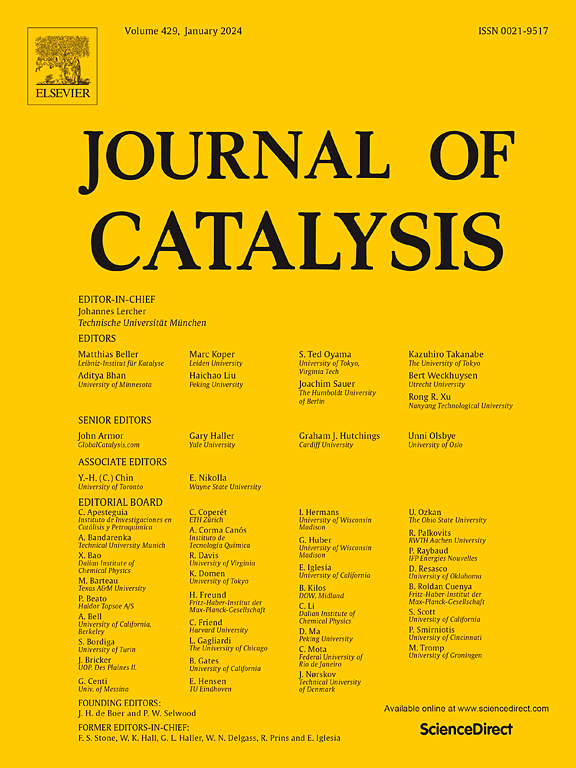Exploring the electronic metal-support interactions in platinum-deposited cobalt oxide catalysts for benzene combustion: A comparison of Pt nanoparticles and site-isolated Pt atoms
IF 6.5
1区 化学
Q2 CHEMISTRY, PHYSICAL
引用次数: 0
Abstract
Insight into metal-support interactions at the nanoscale is of prominent significance in the development of efficient catalysts for volatile organic compound (VOC) abatement. This study investigates catalysts with distinct Pt active centers including Pt nanoparticles (PtNP) and single-atom Pt (Pt1) supported on Mn-Co3O4 and reveals their electronic metal-support interaction characteristics. Benzene combustion tests show a contrasting trend exhibited by these two representative samples. Characterization techniques confirm that the superior performance of PtNP/Mn-Co3O4 stems from promotive electronic interaction. The effective charge transfer enhances reducibility and oxygen activation, coupled with the excellent benzene adsorption capacity of PtNP. However, the inhibitive role of Pt1 in Mn-Co3O4 hinders the lattice oxygen mobility and leads to undesirable performance. Mechanistic insights elucidate the EMSI-induced benefits of being less prone to surface species poisoning, along with detailed reaction mechanisms and benzene decomposition route. This EMSI-dependent understanding of benzene combustion behavior offers valuable insights into the rational design of Pt-based catalysts for benzene abatement.


探索铂沉积的钴氧化物催化剂中电子金属-支撑相互作用的苯燃烧:Pt纳米颗粒和位置隔离Pt原子的比较
在纳米尺度上深入了解金属-载体相互作用对于开发有效的挥发性有机化合物(VOC)减排催化剂具有重要意义。本文研究了具有不同Pt活性中心的催化剂,包括纳米Pt (PtNP)和Mn-Co3O4负载的单原子Pt (Pt1),并揭示了它们的电子金属负载相互作用特性。两种典型样品的苯燃烧试验结果呈现出截然相反的趋势。表征技术证实PtNP/Mn-Co3O4的优异性能源于促进电子相互作用。有效电荷转移增强了PtNP的还原性和氧活化性,加上PtNP优异的苯吸附能力。然而,Pt1在Mn-Co3O4中的抑制作用阻碍了晶格氧的迁移,导致了不良的性能。机制的见解阐明了emsi诱导的不容易受到表面物种中毒的好处,以及详细的反应机制和苯分解途径。这种对苯燃烧行为的emsi依赖的理解为合理设计基于pt的苯减排催化剂提供了有价值的见解。
本文章由计算机程序翻译,如有差异,请以英文原文为准。
求助全文
约1分钟内获得全文
求助全文
来源期刊

Journal of Catalysis
工程技术-工程:化工
CiteScore
12.30
自引率
5.50%
发文量
447
审稿时长
31 days
期刊介绍:
The Journal of Catalysis publishes scholarly articles on both heterogeneous and homogeneous catalysis, covering a wide range of chemical transformations. These include various types of catalysis, such as those mediated by photons, plasmons, and electrons. The focus of the studies is to understand the relationship between catalytic function and the underlying chemical properties of surfaces and metal complexes.
The articles in the journal offer innovative concepts and explore the synthesis and kinetics of inorganic solids and homogeneous complexes. Furthermore, they discuss spectroscopic techniques for characterizing catalysts, investigate the interaction of probes and reacting species with catalysts, and employ theoretical methods.
The research presented in the journal should have direct relevance to the field of catalytic processes, addressing either fundamental aspects or applications of catalysis.
 求助内容:
求助内容: 应助结果提醒方式:
应助结果提醒方式:


